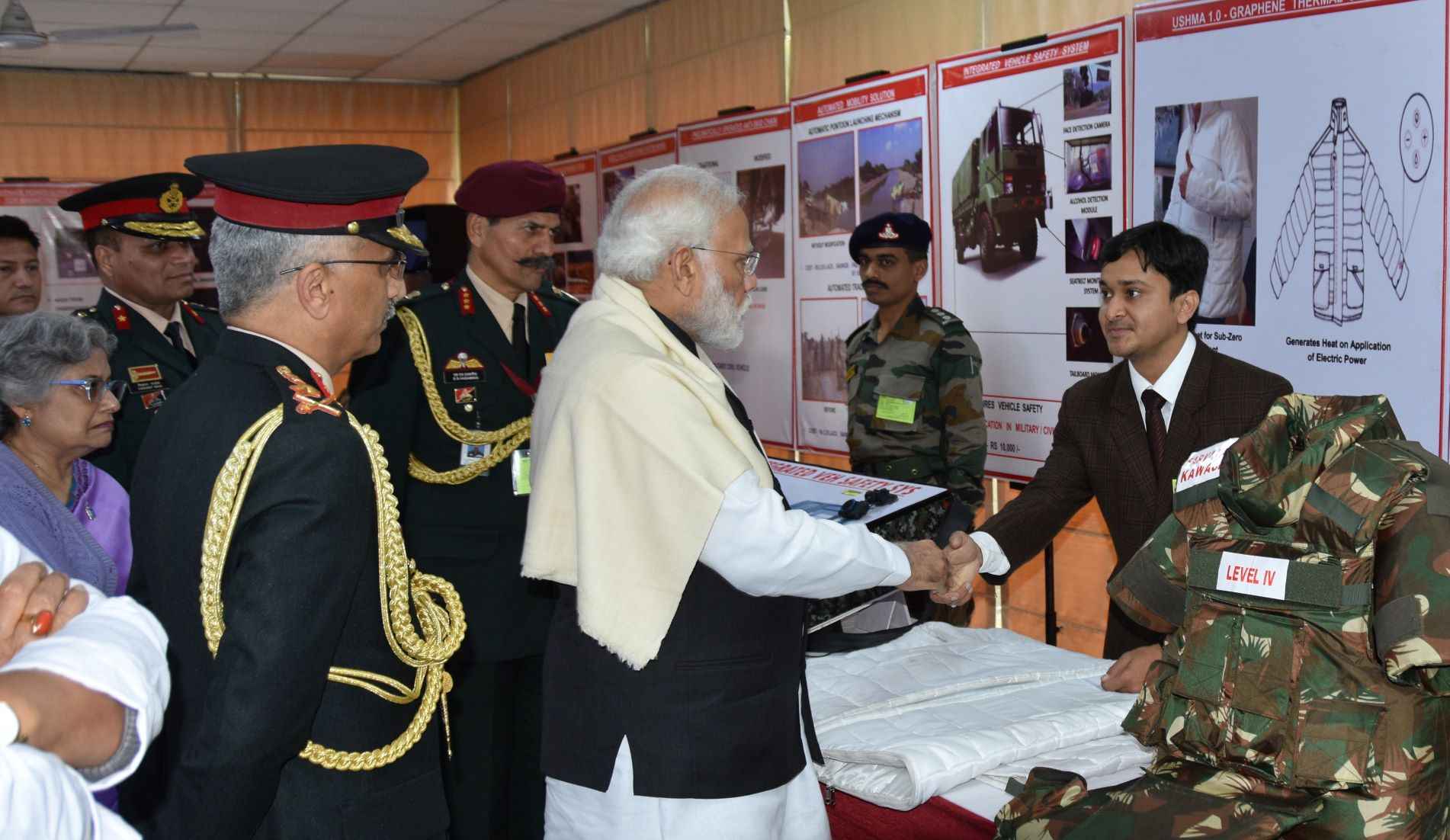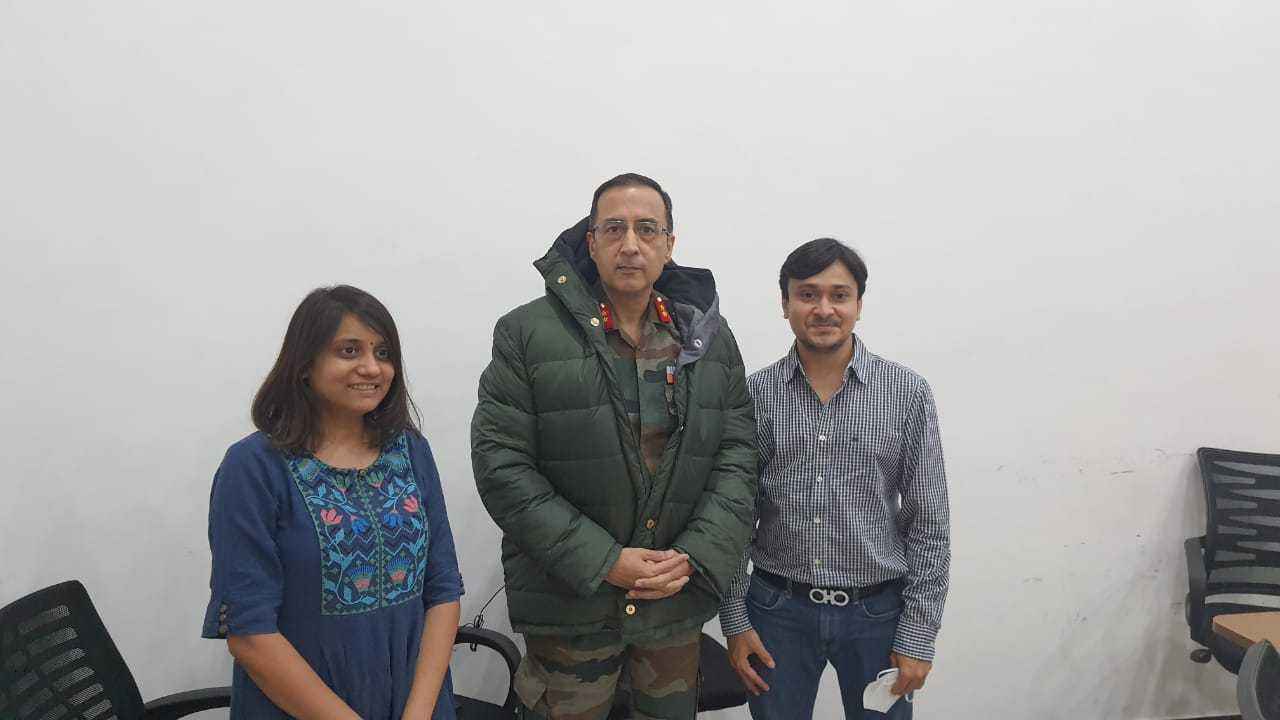Engineers Design Light-Weight AI Jackets to Keep Soldiers Warm in Himalayan Winters
Engineer-duo Neel Panchal and Khushboo Patel have built an AI-powered ‘smart’ jacket made of graphene to help armed forces personnel stay warm and comfortable even in the harshest of climates.

In October 2019, Khushboo Patel, an engineering graduate from Surat, was introduced to Neel Panchal, co-founder of graphene manufacturing startup LHP Nanotechnologies.
“At the time, Neel was looking for someone to develop a wearable garment for the armed forces using graphene,” Khushboo tells The Better India.
She adds that since she had worked on a similar project during her exchange semester in the Netherlands, he thought she would be a good fit.
The duo began working on the concept immediately. Within a month, they managed to come up with a preliminary idea.
Khushboo contributed the knowledge that she had gained during her research project, and the duo also began reading up papers online. Meanwhile, since Neel had been part of a venture that manufactured graphene, they were well aware of the properties of this material.
As Khushboo explains, graphene is exceedingly versatile and far superior and efficient to its counterparts. What lends the material these properties is its structure, which has strong bonds between the carbon atoms. The atomic arrangement of the atoms is such that a sheet of the material is extremely thin, while being flexible and strong.

A study conducted by scientists at University of Manchester’s National Graphene Institute found that clothing made of this material can make the wearer comfortable, whether the temperatures around are hot or cold.
This is due to its property of dynamic thermal radiation, which means that the layers of graphene could change the radiation emitted, depending on temperature.
At the time, the duo did not have a manufacturing space to conduct their experiments, and thus decided to do so in their home kitchen.
“Blenders, mixers, rolling pins….we used them all in the process of coming up with the conductive ink that we were using in our design,” says Khushboo, adding that it must have taken them close to 1,000 trials to finally achieve what they were looking for.
Following a month of intensive work, the duo was ready with the proof of concept of what they called the ‘heated winter jacket’ for Army personnel to wear.
In January 2020, they stood at the Army Chief’s House in Delhi where they presented this concept to Prime Minister Narendra Modi on the occasion of Army Day.
The innovation of the heater jacket
As the duo explains, the jacket is based on the principle that graphene generates heat while using low power. In the months following the presentation of the idea to the Prime Minister, the duo began work on the model, which they completed in February 2022.

The duration of work lasted 30 months, they say, as the jacket has several critical components that require specialised manufacturing processes compared to conventional jackets.
“When we initially began work, we wanted to base the model on the concept that the user could regulate heat generation at his or her convenience,” says Khusboo. “But since it was to be specifically designed for the armed forces, making them fiddle with the regulators and switches would be an unnecessary burden to impose on them. They shouldn’t have to focus on these trivial aspects when their prime duty is so critical in itself.”
The next step was to focus on coming up with a mechanism that would ensure the jacket maintains a comfortable range of temperature on an auto mode. However, as the duo would soon realise, “comfort” was subjective — while one personnel might want a certain temperature to keep warm, for another, that may be uncomfortable.
“To overcome this challenge, we integrated AI,” says Neel. “The software would learn the wearer’s personal preferences in different settings within a short period of time and then begin to adjust to their comfortable temperature.”
Helping men at the frontlines keep warm
While the selling point of the jacket was its ability for ‘smart’ thermoregulation, there are a number of other features that make it a handy assistive product.
“The graphene material offers effective protection against extreme cold temperatures as low as minus 50 degrees Celsius,” says Khushboo, adding that the property of printed electronics ensures that it does not cause any discomfort to the wearer, along with giving a lightweight feeling.
“This eliminates the need to wear multiple layers of warm clothing,” she adds.

She adds that the overlapped front creates an efficient barrier against extreme cold and chilly winds, and thus, even in the absence of a heating system, the wearer can get protection up to minus 30 degrees Celsius.
However, a major roadblock they faced while developing the jacket was the lack of proper technology.
“Smart wearables in India are at a very nascent stage and require a lot of experimentation to establish a production facility,” says Khushboo.
“The existing industrial infrastructure isn’t compatible for prototyping,” says Neel, adding that they rented out a space in Surat for 12 months where they conducted their work, as they did not have a manufacturing unit.
“Additionally, due to the uniqueness of the product, we had to modify the equipment and tools to make numerous components of the jacket,” he says, adding that since these were being designed keeping in mind Army personnel who were posted in extreme climatic conditions, there were plenty of parameters to work on.
“The most crucial parameters were the efficiency of the jacket, ensuring a lightweight nature, longer operating time, durability, and flexibility. Every element had to be redesigned to withstand the harsh climes,” he adds.
However, the duo say that every constraint they were faced with along the way only kept them trying harder and coming up with more ideas.
The road ahead
The jacket is being tested currently, says Khushboo.
“This coming winter, the jackets will be sent to the Army Design Bureau, from where they will be sent to personnel placed at Ladakh and Siachen,” she adds.
Once the performance of the jacket is assessed, it will be ready for sale in January.
While the prototype that they created was for the armed forces that often have to survive through harsh climes, Khushboo says they are working to launch a civilian version by the end of November 2022.
The Army version, they say, will be priced between Rs 85,000 and Rs 1,05,000, whereas the civilian one could range between Rs 25,000 and Rs 65,000. The venture is partially bootstrapped — with the duo investing Rs 7 lakh — and has received government grants worth Rs 27 lakh.
Khushboo says that along with the jacket, efforts have been on to develop apparel-based smart wearables. If you found our stories insightful, informative, or even just enjoyable, we invite you to consider making a voluntary payment to support the work we do at The Better India. Your contribution helps us continue producing quality content that educates, inspires, and drives positive change. Choose one of the payment options below for your contribution- By paying for the stories you value, you directly contribute to sustaining our efforts focused on making a difference in the world. Together, let’s ensure that impactful stories continue to be told and shared, enriching lives and communities alike. Thank you for your support. Here are some frequently asked questions you might find helpful to know why you are contributing?

“We are focused on developing next-generation smart lifestyle products using nanotechnology and also on processes, systems, equipment and tools to support mass manufacturing of these smart products.”
Sources
Graphene clothing stays comfortable whether hot or cold by Materials Today, Published on 1 July 2020.
Edited by Divya Sethu
This story made me
-
97
-
121
-
89
-
167













